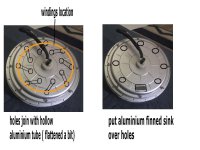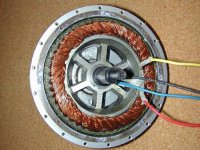stew007
10 W
I think motors can handle quite a bit of dirt and moisture, If we a look at what the RC car crowd give there motors, constant dirt and moisture, it never usually the cause of the demise of the motor, 
Also, if you have the holes so water can escape just as easy as it can get in, then I think there is no worrys. The motor dries out very quickly. Also having a sealed motor, if water does get in, it may accumulate due to the sealed casing, I think I read of this occasional being a corrosion problem on the ebikes.ca site with the crys motors. Also I think dust is not really much a problem, after say 500 if the windings are getting dusty, they can be cleaned through the holes with some compressed air. Larger stones could be a problem if using the bike off road or through deep mud etc, but I have never had any stones bounce towards the hub, the tyres normally seem to eject stones away from the wheel. Also over heating of the motor is likely to cause damage over time, so the cooling outweighs the other risks I think but this is just the risk i'm willing to take, and now after running like this I would say for me the risk is extremely low of damaging the motor.
but this is just the risk i'm willing to take, and now after running like this I would say for me the risk is extremely low of damaging the motor.
As someone else mentioned, the air scoops mounted over the holes would be a great idea, not only would they deflect stones, they would improve airflow, some suction, some compression, that would maximise the airflow
,
Also, if you have the holes so water can escape just as easy as it can get in, then I think there is no worrys. The motor dries out very quickly. Also having a sealed motor, if water does get in, it may accumulate due to the sealed casing, I think I read of this occasional being a corrosion problem on the ebikes.ca site with the crys motors. Also I think dust is not really much a problem, after say 500 if the windings are getting dusty, they can be cleaned through the holes with some compressed air. Larger stones could be a problem if using the bike off road or through deep mud etc, but I have never had any stones bounce towards the hub, the tyres normally seem to eject stones away from the wheel. Also over heating of the motor is likely to cause damage over time, so the cooling outweighs the other risks I think
As someone else mentioned, the air scoops mounted over the holes would be a great idea, not only would they deflect stones, they would improve airflow, some suction, some compression, that would maximise the airflow
,





